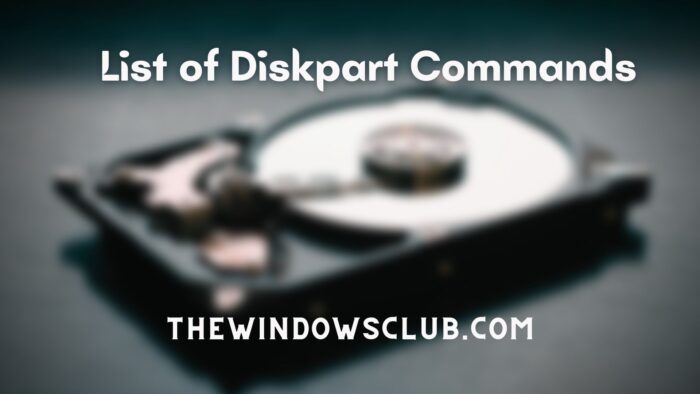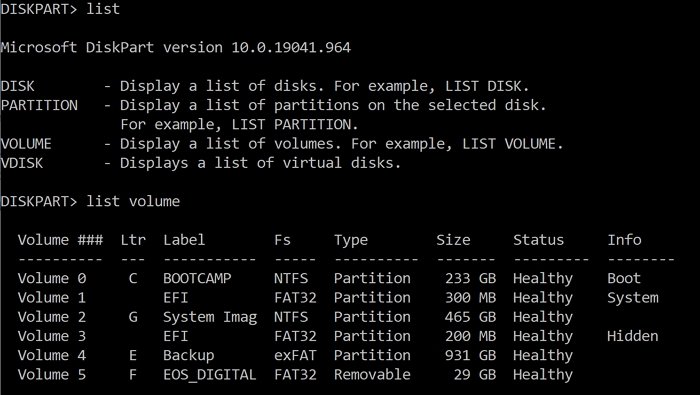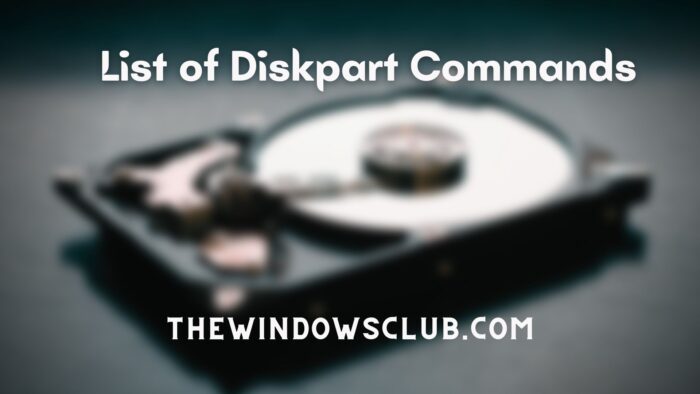Windows comes with a built tool— Disk Management —that offers a complete solution to manage hard disks on the computer. You can use it to shrink volume, increase volume or portion size, create new ones, and so on. The user interface is built using a set of commands— DISKPART — that works on PowerShell or Command Prompt. It comes in handy when you need to run complex commands and work with the virtual hard disk. Diskpart utility has a list of commands that one can use that are shared in the post.

List of Diskpart Commands in Windows 11/10
| active | Marks the disk’s partition with focus as active. |
| add | Mirrors the simple volume with focus to the specified disk. |
| assign | Assigns a drive letter or mount point to the volume with focus. |
| attach vdisk | Attaches (sometimes called mounts or surfaces) a virtual hard disk (VHD) so that it appears on the host computer as a local hard disk drive. |
| attributes | Displays or sets or clears the attributes of a disk or volume. |
| automount | Enables or disables the automount feature. |
| break | Breaks the mirrored volume with focus into two simple volumes. |
| clean | Removes any and all partition or volume formatting from the disk with focus. |
| compact vdisk | Reduces the physical size of a dynamically expanding virtual hard disk (VHD) file. |
| convert | Converts file allocation table (FAT) and FAT32 volumes to the NTFS file system, leaving existing files and directories intact. |
| create | Creates a partition on a disk, a volume on one or more disks, or a virtual hard disk (VHD). |
| delete | Deletes a partition or a volume. |
| detach vdisk | Stops the selected virtual hard disk (VHD) from appearing as a local hard disk drive on the host computer. |
| detail | Displays information about the selected disk, partition, volume, or virtual hard disk (VHD). |
| exit | Exits the diskpart command interpreter. |
| expand vdisk | Expands a virtual hard disk (VHD) to the size that you specify. |
| extend | Extends the volume or partition with focus, along with its file system, into free (unallocated) space on a disk. |
| filesystems | Displays information about the current file system of the volume with focus and lists the file systems that are supported for formatting the volume. |
| format | Formats a disk to accept Windows files. |
| gpt | Assigns the gpt attribute(s) to the partition with focus on basic GUID partition table (gpt) disks. |
| help | Displays a list of the available commands or detailed help information on a specified command. |
| import | Imports a foreign disk group into the disk group of the local computer. |
| inactive | Marks the system partition or boot partition with focus as inactive on basic master boot record (MBR) disks. |
| list | Displays a list of disks, of partitions in a disk, of volumes in a disk, or of virtual hard disks (VHDs). |
| merge vdisk | Merges a differencing virtual hard disk (VHD) with its corresponding parent VHD. |
| offline | Takes an online disk or volume to the offline state. |
| online | Takes an offline disk or volume to the online state. |
| recover | Refreshes the state of all disks in a disk group, attempts to recover disks in an invalid disk group, and resynchronizes mirrored volumes and RAID-5 volumes that have stale data. |
| rem | Provides a way to add comments to a script. |
| remove | Removes a drive letter or mount point from a volume. |
| repair | Repairs the RAID-5 volume with focus by replacing the failed disk region with the specified dynamic disk. |
| rescan | Locates new disks that may have been added to the computer. |
| retain | Prepares an existing dynamic simple volume to be used as a boot or system volume. |
| san | Displays or sets the storage area network (san) policy for the operating system. |
| select | Shifts the focus to a disk, partition, volume, or virtual hard disk (VHD). |
| set id | Changes the partition type field for the partition with focus. |
| shrink | Reduces the size of the selected volume by the amount you specify. |
| uniqueid | Displays or sets the GUID partition table (GPT) identifier or master boot record (MBR) signature for the disk with focus. |
TIP: You can resize a Partition even if Disk Management fails using DISKPART and FSUTIL command-line tools for Disk Management.
How to use Diskpart?

Diskpart runs in its own space, so when you run the command, you will not be able to use the regular commands but only the Diskpart commands.
- Type CMD in the Start screen, and choose to Run as Administrator
- Type Diskpart, and press the Enter key.
- You should see the console to switch from regular Windows path to Diskpart
- Post this; you can start with few basic commands to understand how it works.
Note: Be aware if you choose to delete anything, it cannot be recovered.
Few Basic Commands to Start With Diskpart
- List Disk: Displays number of connected hard drives or storage
- Select Disk <no> : Selects the particular disk
- List Partition: Displays list of partitions for the selected disk
- List Volume: Displays all the partitions of all the disks
How to open DiskPart in Windows?
Open Command Prompt with admin privileges, type Diskpart, and press the Enter key. You can also launch Diskaprt using the Run prompt. Make sure to press Shift + Enter to launch it with admin privileges.
How Do I List Drives in Diskpart?
Once you are inside Diskpart, type List Disk, this will list down all the connected storage, including hard drives, USB storage, SD card, or anything else connected to the PC.
How Do I Delete a Volume or Partition?
- Select Disk <no>
- List Volume
- Select Volume <no>
- Delete Volume
Post this; a confirmation message will show up that Diskpart has successfully deleted the volume. That said, you cannot delete System or Boot Volume. If you are unable to delete it, make sure to read this guide.
How Do I Assign Drive Letter to a Hidden Partition?
If a partition can be seen in the Diskpart tool but is not available through the File Explorer, then it’s because there is no drive letter assigned to it.
- Select Disk <no>
- List Volume
- Select Volume <no>
- assign letter=<alphabet>
Make sure that the assigned alphabet is not already in use.
How to Reduce the Size of a partition?
Before we move ahead, be aware that this is a very long process. Until the process is complete, the drive will be almost useless.
- Select Disk <no>
- List Volume
- shrink desired=<no>
This works for the NTFS file system only.
How to Erase a Disk using Diskpart Clean Command?
- Open Diskpart command in the Command Prompt
- Type list disk and press Enter
- Select the Disk you want to clean using select disk <no>
- Type clean, and press the Enter key
Make sure not to use the clean all command; it will remove all partitions of the selected disk. Also, it will take an hour or so, depending on the disk size, as it will perform a secure erase.
Free Alternatives to Windows Diskpart Utility
These are third-party software that offers a better interface and features compared to Diskpart. In fact, you get to see a preview of the change before the change is committed. Here is a quick list:
- Paragon Partition Manager Free Edition
- Macrorit Disk Partition Expert
- More Disk & Partition Manager software for Windows
I hope you were able to understand how to use it, the list of commands Diskpart houses, and alternatives to Windows Diskpart software that you can use for a better experience.
